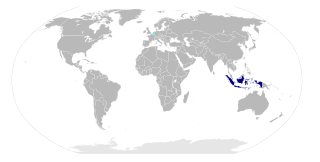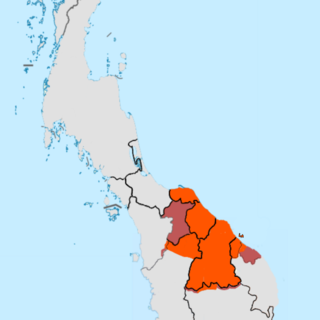Related Research Articles

Indonesian is the official and national language of Indonesia. It is a standardized variety of Malay, an Austronesian language that has been used as a lingua franca in the multilingual Indonesian archipelago for centuries. Indonesia is the fourth most populous nation in the world, with over 279 million inhabitants of which the majority speak Indonesian, which makes it one of the most widely spoken languages in the world. Indonesian vocabulary has been influenced by various languages, including Javanese, Minangkabau, Buginese, Banjarese, Arabic, Dutch, and English. Many borrowed words have been adapted to fit the phonetic, and grammatical rules of Indonesian.

In linguistics, specifically phonetics and phonology, schwa is a vowel sound denoted by the IPA symbol ⟨ə⟩, placed in the central position of the vowel chart. In English and some other languages, it usually represents the mid central vowel sound, produced when the lips, tongue, and jaw are completely relaxed, such as the vowel sound of the ⟨a⟩ in the English word about.

Malay is an Austronesian language that is an official language of Brunei, Indonesia, Malaysia, and Singapore, and that is also spoken in East Timor and parts of Thailand. Altogether, it is spoken by 290 million people across Maritime Southeast Asia.
While many languages have numerous dialects that differ in phonology, the contemporary spoken Arabic language is more properly described as a continuum of varieties. This article deals primarily with Modern Standard Arabic (MSA), which is the standard variety shared by educated speakers throughout Arabic-speaking regions. MSA is used in writing in formal print media and orally in newscasts, speeches and formal declarations of numerous types.
English phonology is the system of speech sounds used in spoken English. Like many other languages, English has wide variation in pronunciation, both historically and from dialect to dialect. In general, however, the regional dialects of English share a largely similar phonological system. Among other things, most dialects have vowel reduction in unstressed syllables and a complex set of phonological features that distinguish fortis and lenis consonants.
In an alphabetic writing system, a silent letter is a letter that, in a particular word, does not correspond to any sound in the word's pronunciation. In linguistics, a silent letter is often symbolised with a null sign U+2205∅EMPTY SET. Null is an unpronounced or unwritten segment. The symbol resembles the Scandinavian letter Ø and other symbols.

Kelantan-Pattani Malay is an Austronesian language of the Malayic subfamily spoken in the Malaysian state of Kelantan, as well as in Besut and Setiu districts of Terengganu state and the Perhentian Islands, and in the southernmost provinces of Thailand. It is the primary spoken language of Thai Malays, but is also used as a lingua franca by ethnic Southern Thais in rural areas, Muslim and non-Muslim and the Sam-Sam, a mostly Thai-speaking population of mixed Malay and Thai ancestry.
The phonology of the Persian language varies between regional dialects, standard varieties, and even from older variates of Persian. Persian is a pluricentric language and countries that have Persian as an official language have separate standard varieties, namely: Standard Dari (Afghanistan), Standard Iranian Persian and Standard Tajik (Tajikistan). The most significant differences between standard varieties of Persian are their vowel systems. Standard varieties of Persian have anywhere from 6 to 8 vowel distinctions, and similar vowels may be pronounced differently between standards. However, there are not many notable differences when comparing consonants, as all standard varieties a similar amount of consonant sounds. Though, colloquial varieties generally have more differences than their standard counterparts. Most dialects feature contrastive stress and syllable-final consonant clusters.
This article discusses the phonological system of the Czech language.
The Rheinische Dokumenta is a phonetic writing system developed in the early 1980s by a working group of academics, linguists, local language experts, and local language speakers of the Rhineland. It was presented to the public in 1986 by the Landschaftsverband Rheinland.

Hamza is a letter in the Arabic alphabet, representing the glottal stop. Hamza is not one of the 28 "full" letters and owes its existence to historical reform of standard writing system. It is derived from the Arabic letter ʿAyn. In the Phoenician, Hebrew and Aramaic alphabets, from which the Arabic alphabet is descended, the glottal stop was expressed by alif (𐤀), continued by Alif (ا) in the Arabic alphabet. However, Alif was used to express both a glottal stop and a long vowel. In order to indicate that a glottal stop is used, and not a mere vowel, it was added to Alif diacritically. In modern orthography, hamza may also appear on the line, under certain circumstances as though it were a full letter, independent of an Alif.
Sarawak Malay is a Malayic language native to the State of Sarawak. It is a common language used by natives of Sarawak and also as the important mother tongue for the Sarawakian Malay people.
Kensiu (Kensiw) is an Austro-asiatic language of the Jahaic subbranch. It is spoken by a small community of 300 in Yala Province in southern Thailand and also reportedly by a community of approximately 300 speakers in Western Malaysia in Perak and Kedah states. Speakers of this language are Negritos who are known as the Mani people or Maniq of Thailand.
The Dhao language, better known to outsiders by its Rotinese name Ndao, is the language of Ndao Island in Indonesia. Traditionally classified as a Sumba language in the Austronesian family, it may actually be a non-Austronesian (Papuan) language. It was once considered a dialect of Hawu, but is not mutually intelligible.

The Van Ophuijsen Spelling System was the Romanized standard orthography for the Indonesian language from 1901 to 1947. Before the Van Ophuijsen Spelling System was in force, the Malay language in the Dutch East Indies did not have a standardized spelling, or was written in the Jawi script. In 1947, the Van Ophuijsen Spelling System was replaced by the Republican Spelling System.
The Indonesian-Malaysian orthography reform of 1972 was a joint effort between Indonesia and Malaysia to harmonize the spelling system used in their national languages, which are both forms of the Malay language. For the most part, the changes made in the reform are still used today. This system uses the Latin alphabet and in Malaysia is called Joint Rumi Spelling, and in Indonesia Perfect Spelling or Enhanced Spelling. It replaced the Za'aba Spelling that was previously standard in Malaysia, Singapore and Brunei, and the Republican Spelling System in Indonesia.
Pahang Malay is a Malayic language spoken in the Malaysian state of Pahang. It is regarded as the dominant Malay dialect spoken along the vast riverine systems of Pahang, but co-exists with other Malay dialects traditionally spoken in the state. Along the coastline of Pahang, Terengganu Malay is spoken in a narrow strip of sometimes discontiguous fishing villages and towns. Another dialect spoken in Tioman island is a distinct Malay variant and most closely related to Riau Archipelago Malay subdialect spoken in Natuna and Anambas islands in the South China Sea, together forming a dialect continuum between the Bornean Malay and the Mainland Peninsular/Sumatran Malay.
Perak Malay is one of the Malay dialects spoken within the state of Perak, Malaysia. Although it is neither the official language nor the standard dialect in the whole state of Perak, its existence which co-exists with other major dialects in the state of Perak still plays an important role in maintaining the identity of Perak. In spite of the fact that there are five main dialects traditionally spoken in Perak, only one of which is intended by the name "Perak Malay". There are subtle phonetic, syntactic and lexical distinctions from other major Malay dialects. Perak Malay can be divided into two sub-dialects, Kuala Kangsar and Perak Tengah, named after the daerah (districts) where they are predominantly spoken.
The phonological system of the Hejazi Arabic consists of approximately 26 to 28 native consonant phonemes and 8 vowel phonemes:. Consonant length and vowel length are both distinctive in Hejazi.
The Congress Spelling System is a spelling reform of Malay Rumi Script introduced during the third Malay Congress held in Johor Bahru and Singapore in 1956. The main characteristics of the system are the use of symbols in the Americanist phonetic notation, going by the dictum of one symbol for one phoneme, and the new proposition in the writing of diphthongs.
References
- 1 2 3 4 Abu Bakar, Mukhlis (2019-12-18). "Sebutan Johor-Riau dan Sebutan Baku dalam Konteks Identiti Masyarakat Melayu Singapura". Issues in Language Studies. 8 (2). doi: 10.33736/ils.1521.2019 . ISSN 2180-2726.
- 1 2 3 4 5 6 7 Clynes, Adrian; Deterding, David (August 2011). "Standard Malay (Brunei)". Journal of the International Phonetic Association. 41 (2): 259–268. doi: 10.1017/S002510031100017X . Archived from the original on 2021-08-16.
- 1 2 Karim, Nik Safiah; M. Onn, Farid; Haji Musa, Hashim; Mahmood, Abdul Hamid (2008). Tatabahasa Dewan (in Malay) (3 ed.). Kuala Lumpur: Dewan Bahasa dan Pustaka. pp. 297–303. ISBN 978-983-62-9484-5.
- 1 2 3 4 Soderberg, Craig D.; Olson, Kenneth S. (2008). "Indonesian". Journal of the International Phonetic Association. 38 (2): 209–213. doi: 10.1017/S0025100308003320 .
- ↑ Asmah Haji Omar (2008). Ensiklopedia Bahasa Melayu. Kuala Lumpur: Dewan Bahasa dan Pustaka, page 108.
- ↑ Yunus Maris, M. (1980). The Malay Sound System. Kuala Lumpur: Penerbit Fajar Bakti Sdn. Bhd, page 52.
- ↑ S., Effendi (2012). Panduan Berbahasa Indonesia dengan Baik dan Benar (Guidebook for Speaking Indonesian Well and Correct). Dunia Pustaka Jaya. p. 228. ISBN 978-6232212350.
- ↑ Jiang Wu (2023). Malayic varieties of Kelantan and Terengganu. Amsterdam: LOT Publications. p. 42. ISBN 978-94-6093-436-0.
- ↑ To Tap or Not To Tap: A Preliminary Acoustic Description of American English Alveolar Tap Productions by Indonesian Bilingual Adults
- ↑ This is the argument for the nasal being underlyingly /ŋ/: when there is no place for it to assimilate to, it surfaces as /ŋ/. Some treatments write it /N/ to indicate that it has no place of articulation of its own, but this fails to explain its pronunciation before vowels.
- ↑ "KPST dan Kaidah Peluluhan Fonem (KPST and Phoneme Loss Rule)". Kompas.id. 28 December 2019. Retrieved 8 October 2021.
- ↑ Asmah Haji Omar (2008). Ensiklopedia Bahasa Melayu. Kuala Lumpur: Dewan Bahasa dan Pustaka, page 97.
- ↑ Yunus Maris, M. (1980). The Malay Sound System. Kuala Lumpur: Penerbit Fajar Bakti Sdn. Bhd, page 2.
- ↑ Asmah Haji Omar. (1977). The phonological diversity of the Malay dialects. Kuala Lumpur: Dewan Bahasa dan Pustaka.
- ↑ Pedoman Umum Ejaan Bahasa Indonesia (PDF). Jakarta: Kementerian Pendidikan dan Kebudayaan Republik Indonesia. 2015.
- 1 2 "EYD V". ejaan.kemdikbud.go.id. Retrieved 2022-08-22.
- ↑ Clynes, Adrian (1997). "On the Proto-Austronesian "Diphthongs"". Oceanic Linguistics. 36 (2): 347–362. doi:10.2307/3622989. JSTOR 3622989.
- 1 2 Zuraidah Mohd Don, Knowles, G., & Yong, J. (2008). How words can be misleading: A study of syllable timing and "stress" in Malay. The Linguistics Journal 3(2). See here
- ↑ Gil, David. "A Typology of Stress, And Where Malay/Indonesian Fits In (abstract only)" (PDF). Archived from the original (PDF) on 2012-02-25. Retrieved 2012-03-25.
- ↑ Roach, P. (1982). On the distinction between 'stress-timed' and 'syllable-timed' languages. In D. Crystal (Ed.), Linguistic Controversies (pp.73–79). London: Edward Arnold.
- ↑ Deterding, D. (2011). Measurements of the rhythm of Malay. In Proceedings of the 17th International Congress of Phonetic Sciences, Hong Kong, 17–21 August 2011, pp. 576–579. On-line Version
- ↑ Adelaar, K.A. (1992). Proto-Malayic: The reconstruction of its phonology and parts of its lexicon and morphology (PDF). Canberra: Pacific Linguistics, The Australian National University. doi:10.15144/pl-c119.